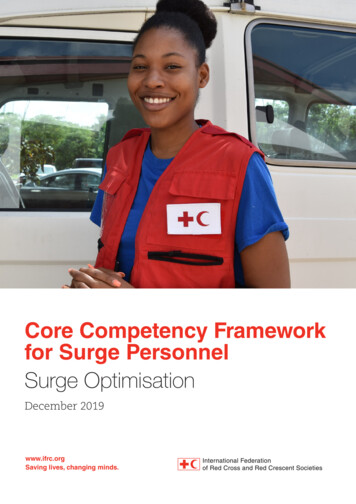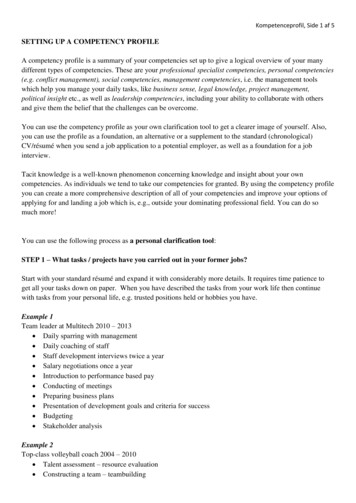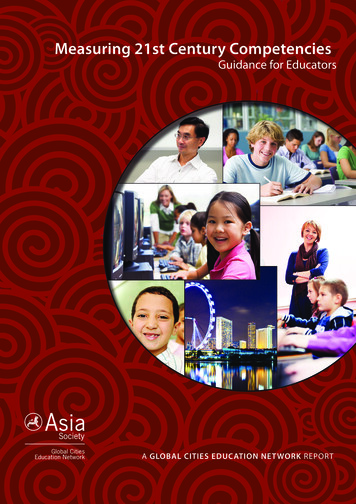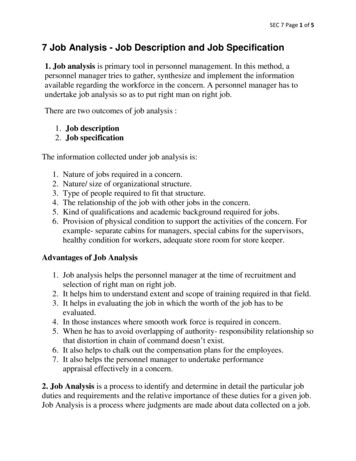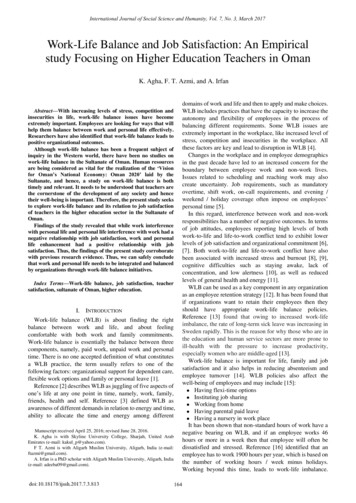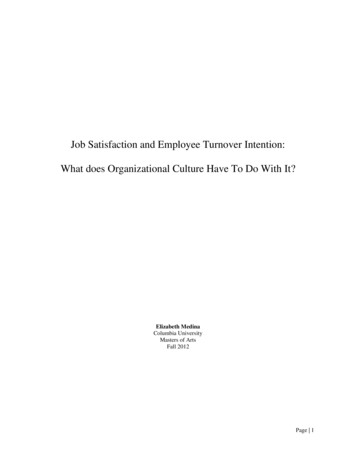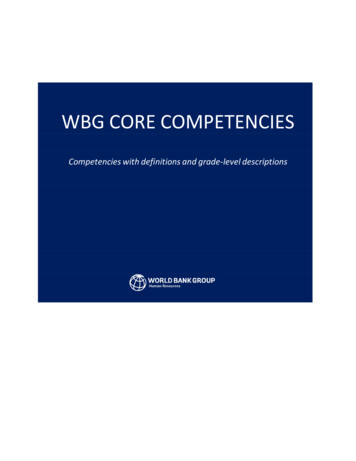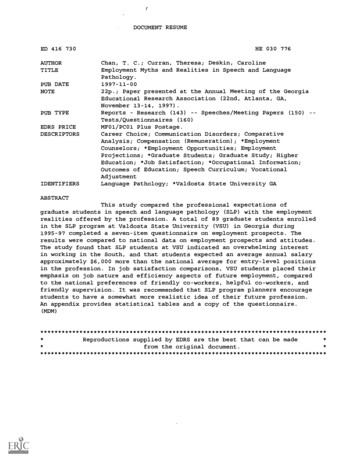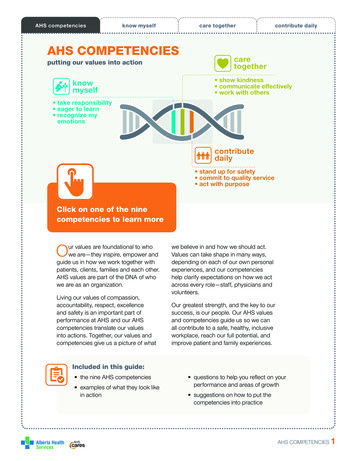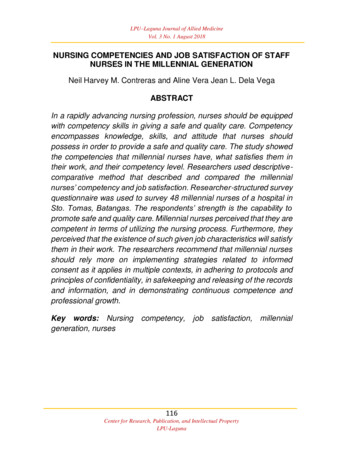
Transcription
LPU–Laguna Journal of Allied MedicineVol. 3 No. 1 August 2018NURSING COMPETENCIES AND JOB SATISFACTION OF STAFFNURSES IN THE MILLENNIAL GENERATIONNeil Harvey M. Contreras and Aline Vera Jean L. Dela VegaABSTRACTIn a rapidly advancing nursing profession, nurses should be equippedwith competency skills in giving a safe and quality care. Competencyencompasses knowledge, skills, and attitude that nurses shouldpossess in order to provide a safe and quality care. The study showedthe competencies that millennial nurses have, what satisfies them intheir work, and their competency level. Researchers used descriptivecomparative method that described and compared the millennialnurses’ competency and job satisfaction. Researcher-structured surveyquestionnaire was used to survey 48 millennial nurses of a hospital inSto. Tomas, Batangas. The respondents’ strength is the capability topromote safe and quality care. Millennial nurses perceived that they arecompetent in terms of utilizing the nursing process. Furthermore, theyperceived that the existence of such given job characteristics will satisfythem in their work. The researchers recommend that millennial nursesshould rely more on implementing strategies related to informedconsent as it applies in multiple contexts, in adhering to protocols andprinciples of confidentiality, in safekeeping and releasing of the recordsand information, and in demonstrating continuous competence andprofessional growth.Key words: Nursinggeneration, nursescompetency, jobsatisfaction, millennial116Center for Research, Publication, and Intellectual PropertyLPU-Laguna
LPU–Laguna Journal of Allied MedicineVol. 3 No. 1 August 2018INTRODUCTIONModern nursing began in the 19 th century with the help ofFlorence Nightingale. Nursing became more important than ever asnurses were needed to aid the wounded soldiers during the CrimeanWar to Civil War. During this war, deaths from injuries were verycommon; this resulted to an infection outbreak. Nightingale became anadvocate of sanitary living conditions for patients who were beingtreated in the hospitals. There were also nurses who joined the ranksthat brought larger focus on the profession as nurses were also a greathelp in the military hospitals; these nurses are also recognized officiallyas military nurses. It spread throughout the entire nursing professionthroughout the years, until now. These nurses were satisfied by theachievement, recognition, and respect that they received (Sayles,2017).In a rapidly advancing nursing profession, nurses are expectedto use their competency skills in giving a safe and quality care.Competency encompasses knowledge, skills and attitude that nursesshould possess in order to provide a safe and quality care. Comparedto the previous generations, the millennial generations are morecompetent in terms of giving care with the use of advance technology(van Graan, Williams, & Koen, 2016).According to the 2012 National Nursing Core CompetencyStandards, there are 5 competencies being used to evaluate a nurse,these are (1) Practices with Legal Principles and Code of Ethics inmaking professional judgment, (2) Promotes safe quality care, (3)Complete and accurate recording and reporting system, (4)Collaboration relationship with other colleagues, and (5) Professionaland personal growth development (Labour Organization, 2014).In order to be competent, job satisfaction must be achieved.Job satisfaction is the level of contentment a person has about his orher job. It has been said that job satisfaction affects the competency of117Center for Research, Publication, and Intellectual PropertyLPU-Laguna
LPU–Laguna Journal of Allied MedicineVol. 3 No. 1 August 2018a person. If a person is not satisfied with his or her work, he or she willnot perform well (Sayles, 2017).Since each generation differs in characteristics, job satisfaction,and competency level, the purpose of this study is to know thecompetencies that millennial nurses have and what satisfies them intheir work. In addition, the researchers studied the different types ofproblems that millennial nurses face and how competency relates withtheir job satisfaction. Competency and job satisfaction of millennialnurses may continue over time. By having this research study, futurenurses will gain knowledge and insight about balancing and managingcompetency in their professional practice and, at the same time, feelconsiderable satisfaction on the job experience that they have.Objectives of the studyThe purpose of this study was to determine the competenciesand job satisfaction of the millennial nurses. Specifically, this studysought to:1. Determine the profile of millennial nurses in terms of:1.1 gender;1.2 length of service; and1.3 clinical area assigned;2. Determine the nursing competencies of staff nurses interms of:2.1 practicing in accordance with legal principles and thecode of ethics in making personal and professionaljudgment,118Center for Research, Publication, and Intellectual PropertyLPU-Laguna
LPU–Laguna Journal of Allied MedicineVol. 3 No. 1 August 20182.2 utilizing the nursing process in the interdisciplinarycare of clients that empowers the client and promotessafe quality care,2.3 maintaining complete, accurate and up to daterecording and reporting system,2.4 establishing collaborative relationship with othercolleagues and other member of the team to enhancenursing and other health services, and2.5 promoting professional and personal growthdevelopment.3. Determine the level of job satisfaction of staff nurses interms of:3.1 physiologic aspect;3.2 safety aspect;3.3 social aspect;3.4 self-esteem aspect; and3.5 self-actualization aspect.4. Determine if there is a significant relationship between thecompetencies and job satisfaction of the millenial nurses.5. Determine if there is significant difference between thecompetencies and job satisfaction of millenial nurses whengrouped according to their profile.119Center for Research, Publication, and Intellectual PropertyLPU-Laguna
LPU–Laguna Journal of Allied MedicineVol. 3 No. 1 August 2018METHODOLOGYResearch DesignThe study used the descriptive-comparative method thatdescribes and compares the competency and job satisfaction ofmillennial nurses.The descriptive method of research involves as a certain datagathering process on prevailing conditions and practice or descriptionof objects, process, or persons as they exist for about a certaineducational phenomenon, predicting for identifying relationship amongand between the available described.The comparative method of research involves comparing andcontrasting two or more samples of study subjects on one or morevariables, often at a single point of time.Research LocaleThe research study was conducted in a 220-bed capacityprivate secondary level medical center, recognized as a center ofexcellence – the highest level of quality accreditation – by the PhilippineHealth insurance corporation (Phil Health) located at Sto. ThomasBatangas, Philippines. The researchers chose this tertiary level medicalcenter since it is internationally known for its nursing care services,committed to meet the healthcare needs of patients through a diversegroup of competent and compassionate professionals. The NursingService department prides itself in its organizational culture whereexcellence in the practice of the profession is valued as essential forquality healthcare through leadership, research, evidenced-basedpractice, continuous professional development, and patient-safety asits roots to a larger and comprehensive delivery of patient-centeredservices.120Center for Research, Publication, and Intellectual PropertyLPU-Laguna
LPU–Laguna Journal of Allied MedicineVol. 3 No. 1 August 2018Respondents of the StudyThe respondents of the study were 48 staff nurses chosenthrough purposive sampling technique. The age of the respondentsranges from twenty-one (21) to thirty-six (36) years old, currentlyemployed in the institution regardless of gender, length of service, andclinical area assigned. The sample size was calculated using G-PowerSoftware. The effect size was at 0.35, alpha error probability of 0.10,and power of 0.90.Research InstrumentThe data gathering was aided by a researcher-structuredquestionnaire items adopted from 2012 NNCCS and Maslow’sHierarchy of Needs for Nurses. The tool was composed of three parts.The first part contained the demographic profile of the correspondentsin terms of gender, length of service, and assigned department. Thesecond part comprised the items on nursing competencies, groupedaccording to legal and ethical principles (5 items), safe and quality care(7 items) , recording and reporting system (5 items), collaboration withother health team members (5 items), and personal and professionalgrowth (5 items). The third part included the items on the jobsatisfaction of staff nurses which were grouped according tophysiologic aspect (items 1-5), safety aspect (item 6), social aspect(items 7-12), self-esteem aspect (items 13-21), and self-actualizationaspect (item 22). Maslow’s heiarchy of needs was the basis of the itemsin this portion. Before data gathering, the researchers have done pilottesting to know if the questionnaire were reliable. The result wascomputed by the statistician. The results were Cronbach alpha r .955for part 1, r .936 for part 2, and r .937 overall. These result showedthat the researcher-structured questionnaire was reliable for datagathering.121Center for Research, Publication, and Intellectual PropertyLPU-Laguna
LPU–Laguna Journal of Allied MedicineVol. 3 No. 1 August 2018Data Gathering ProcedureThe researchers provided a request permission letter to theDean of the College of Allied Medicine to approve the survey, and tothe Chief Nurse of the chosen hospital to ask for the permission of thestaff nurses who would like participate to the research study. Surveyquestionnaire was the main instrument for data gathering in the study.Researchers got 48 millennial nurses aged between 21-36 years old ata 220-bed capacity tertiary level medical center located at Batangas,Philippines. They pointed out their socio-demographic profiles,competencies, and job satisfaction. The researchers allocated onemonth to gather data from the chosen hospitals. The researchers hadthe actual distribution of the questionnaires to the chosen group ofrespondents.Ethical considerationEthical aspect is considered important to protect therespondents. Informed consent and appropriate permission from therespondents were provided. Confidentiality of the respondents wasstrictly maintained to ensure privacy of the data. Anonymity wasmaintained to secure the respondent’s identity. Respondents maywithdraw at any point of data gathering since the participation wasvoluntary. All the data gathered were used for this study. The datacollected were stored in a private storage.Statistical TreatmentFrequency tables were used to determine the profile of staffnurses in terms of length of service and department assigned.Weighted mean was applied to determine the competencies and jobsatisfaction of staff nurses. Pearson’s r was used to determine the levelof job satisfaction of staff nurses. T-test was utilized to determine ifthere is significant relationship between the competencies and jobsatisfaction of millennial nurses. ANOVA was utilized to determine if122Center for Research, Publication, and Intellectual PropertyLPU-Laguna
LPU–Laguna Journal of Allied MedicineVol. 3 No. 1 August 2018there is significant difference between the competencies and jobsatisfaction of millennial nurses when grouped according to their profile.RESULTS AND DISCUSSIONSocio-Demographic ProfileTable 1. Profile of millennial nurses in terms of 52.110.4Total48100.0Table 1 shows the profile of millennial nurses in terms of gender.The majority in this frequency table were female (52.1% of the totalpopulation). The findings revealed that nursing at present is stillconsidered a profession dominated by the female group. This resultshows that there were more female nurses than male and LGBT.Table 2. Profile of millennial nurses in terms of length in serviceLength of ServiceFrequencyPercent0 to less than 1 year1 to less than 2 years2 years3 to 5 yearsMore than 5 r for Research, Publication, and Intellectual PropertyLPU-Laguna
LPU–Laguna Journal of Allied MedicineVol. 3 No. 1 August 2018Table 2 shows the profile of millennial nurses in terms of lengthin service. 43.8% of the total population were 0 to less than 1 year inservice. 4.2% of the total population were more than 5 years in service.The findings indicated that there were more novice nurses thanadvanced beginners, competent, and even expert nurses. The absenceof nurses with longer years in service can be attributed to the increasedrate of experienced staff nurses who decided to leave their post inexchange of a better work condition abroad, or a shift to other workwhich offer higher salary. This result shows that many of therespondents were novice in the profession.Table 3. Profile of millennial nurses in terms of clinical areaassignedClinical Area AssignedFrequencyPercentGeneral Ward2654.2Emergency Department816.71429.248100.0Special Unit(ICU,Chemotherapy)OR,TotalDR,Dialysis,Table 3 shows the profile of millennial nurses in terms ofdepartment that they were assigned. The majority of the millennialnurses who were assigned in general ward (54.2% of the population).General wards are commonly the initial areas of assignment given tothe new staff nurses. These areas do not require special skills like the124Center for Research, Publication, and Intellectual PropertyLPU-Laguna
LPU–Laguna Journal of Allied MedicineVol. 3 No. 1 August 2018special areas where competent and proficient nurses work. Wards alsohas more patient and do not need close watching like the patients inthe ICU, or dialysis unit which need one on one interaction. Theseresults show that many of the respondents were from the general ward.Nursing CompetencyTable 4. Nursing competencies of staff nurses in terms of practicein accordance with legal principles and the code of ethics inmaking personal and professional judgement.ItemsMeanAdheres to ethico-legal considerations whenproviding safe, quality and professional nursingcare.Protects clients rights based on “Patient’s Bill ofRights and Obligations.4.23Applies ethical reasoning and decision-makingprocess to address situations of ethical distressand moral dilemma.Adheres to established norms of conduct basedon the Philippine Nursing Law and other legal,regulatory and institutional requirementsrelevant to safe nursing practice.4.19Implements strategies/policies related toinformed consent as it applies in multiplecontexts.Composite mean4.10InterpretationModerately Competent4.21Moderately CompetentModerately Competent4.13Moderately CompetentModerately Competent4.172ModeratelyCompetentLegend: 4.5-5.00- Highly Competent, 3.5-4.49- Moderately Competent, 2.5-3.49Competent, 1.5-2.49- Slightly Competent, 1.0-1.49- Not CompetentTable 4 shows the nursing competencies of staff nurses interms of practice in accordance with legal principles and the code ofethics in making personal and professional judgement. The result in thistable shows that the respondents were moderately competent with acomposite mean of 4.172. Adheres to ethico-legal considerations when125Center for Research, Publication, and Intellectual PropertyLPU-Laguna
LPU–Laguna Journal of Allied MedicineVol. 3 No. 1 August 2018providing safe, quality, and professional nursing care had the highestmean of 4.23, and the lowest mean of 4.10 for Implementsstrategies/policies related to informed consent as it applies in multiplecontexts. Nurses always practice ethico-legal considerations along withother healthcare providers in providing safe and quality care for theclient. Implementation of informed consents to clients are appliedunder rules and policies.Professional code of ethics must be used by the nurses to utilizeclinical judgement inherent in the process of assessment, diagnosis,implementation and evaluation. Professional nurses were expected bythe health care institutions in joining the workforce to be highlycompetent and prepared to function in health care arena. Thecontinuous increase of the changes in the demands of practice wascharacterized by uncertainity. Despite of that, nurses should still haveto make clinical decisions and judgements, and it should be based onthe legal and ethical principles of nurses (van Graan et al., 2016).One of the vital skills that nurses should have is clinicaljudegement that enables them to determine the appropriate nursinginterventions when planning patient care at all times, especially whentreating patient who needs emergency judgement (Lindsey & Jenkins2013).126Center for Research, Publication, and Intellectual PropertyLPU-Laguna
LPU–Laguna Journal of Allied MedicineVol. 3 No. 1 August 2018Table 5. Nursing competency of staff nurse in terms of utilizingthe nursing process in the interdisciplinary care of clients thatempowers the client and promotes safe quality care.ItemsMeanInterpretationDocuments client’s responses, nursing careservices rendered, processes and outcomes ofthe nurse-client working relationship4.29ModeratelyCompetentImplements safe and quality interventions withthe client to address the health needs,problems and issues.4.25ModeratelyCompetentAssesses with the client one’s health status.4.19ModeratelyCompetentEnsures a working relationship with the clientand/or support system based on trust respectand shared decision making.4.17ModeratelyCompetentProvide health teachingplanning models.selected4.15ModeratelyCompetentEvaluates with the client the health statusand/or expected outcomes of nurse-clientworking relationship.4.15ModeratelyCompetentFormulates with the client a plan of care toaddress the health conditions, needs,problems and issues based on priorities.4.04ModeratelyCompetentComposite Mean4.177ModeratelyCompetentusingLegend: 4.5-5.00- Highly Competent, 3.5-4.49- Moderately Competent, 2.5-3.49- Competent, 1.52.49- Slightly Competent, 1.0-1.49- Not CompetentTable 5 shows that all items were assessed as moderatelycompetent in terms of utilizing the nursing process in theinterdisciplinary care of clients that empowers the client and promotessafe quality care had a composite mean of 4.177. Documents, client’sresponses, nursing care services rendered, processes, and outcomesof the nurse-client working relationship had the highest mean of 4.29,127Center for Research, Publication, and Intellectual PropertyLPU-Laguna
LPU–Laguna Journal of Allied MedicineVol. 3 No. 1 August 2018and the lowest mean of 4.04 for formulates with the client a plan of careto address the health conditions, needs, problems, and issues basedon priorities. Documentation of care rendered to the client and it’soutcomes during nurse-client interaction were mostly performed.Nurses and clients should have an intact communication to addresshealth conditions. The formulation of plan of care for clients should beprioritized.Researchers in Czech Republic studied about thecompetencies of members of nursing teams in inpatient facilities. Theresult showed that all members of nursing team did not fulfil or overstepbeyond their “internal” and “external” competencies. Practice nursesperform all nursing activities which are supposed to be performed byless qualified members of the nursing team. The reason behind thiswas lack of time to perform the activities and practice nurses performactivities which were in the competence of the doctors. Practice nurseswere forced to perform activities beyond the scope of their professionalactivities such as performing hygiene care, serve food and feedpatients, do bed making or bedside care, dilute disinfectants, andaccompany patients to examination laboratories. They perform all ofthese tasks despite of having nursing assistants, nurse aids, andmedical assistants (OváMikš, Šamaj, Machálková, & Ivanová, 2014).Table 6. Nursing competency of staff nurse in terms of maintainingcomplete, accurate and up-to-date recording and reportingsystem.ItemsMeanEnsures completeness, integrity, 4.23safety, accessibility and security ofinformation.Utilizes acceptable, up to date, and 4.19available system of atelyCompetent128Center for Research, Publication, and Intellectual PropertyLPU-Laguna
LPU–Laguna Journal of Allied MedicineVol. 3 No. 1 August 2018Table 6 continued Implements system of informatics tosupport the delivery of health care4.13ModeratelyCompetentAdheres to protocols and principles 4.06of confidentiality in safekeeping andreleasing of the records andinformation.ModeratelyCompetentDocuments data on client careclearly, concisely, accurately, and ina timely manner.Composite tLegend: 4.5-5.00- Highly Competent, 3.5-4.49- Moderately Competent,2.5-3.49- Competent, 1.5-2.49- Slightly Competent, 1.0-1.49- NotCompetentTable 6 shows that all items were assessed as moderatelycompetent in terms of maintaining complete, accurate, and up-to-daterecording and reporting had a composite mean of 4.177. Ensurescompleteness, integrity, safety, accessibility and security of informationhad the highest mean of 4.23, and the lowest mean of 4.04 for thedocuments data on client care clearly, concisely, accurately, and in atimely manner. Recording and reporting system in hospital were highlyperformed. Nurses ensured complete and accessible information,especially security of client’s information as a legal document.Documentation of client’s data secondary to Implementation of nursingcare was done accurately for every client.In a study conducted among Korean nurses, clinical error is aproblem that they always encounter. Identifying the nature of clinicalerrors in clinical area is necessary for the reduction of errors effectively.Error-reporting systems had been implemented by many healthcareinstitutions. In helping to detect incidents behind patients safety andproviding opportunities that improves systems performance and129Center for Research, Publication, and Intellectual PropertyLPU-Laguna
LPU–Laguna Journal of Allied MedicineVol. 3 No. 1 August 2018prevention of patients safety risks in the future, data and informationwere analyzed through clinical error reporting. To create a saferhealthcare system, clinical error reporting is essential. On the otherhand, underreporting of clinical errors is a major challenge in improvingpatients safety (Hwang & Ahn, 2015).Table 7. Nursing competency of staff nurse in terms ofEstablishing Collaborative Relationship with Other Colleaguesand Other member of the Team to Enhance Nursing and OtherHealth Care Services.ItemsMeanInterpretationImplements strategies or approaches toenhance and support the capability of theclient and care providers to participate indecision making.4.23ModeratelyCompetentRespect the role of the other members of 4.17the health team.ModeratelyEnsures effective collaboration in thedelivery of health care.4.06ModeratelySupports the views of clients/families and/or care tActs as liaison/advocate of the client 4.00during decision making by the interprofessional team.ModeratelyComposite MeanModerately4.098CompetentCompetentLegend: 4.5-5.00- Highly Competent, 3.5-4.49- Moderately Competent,2.5-3.49- Competent, 1.5-2.49- Slightly Competent, 1.0-1.49- NotCompetent130Center for Research, Publication, and Intellectual PropertyLPU-Laguna
LPU–Laguna Journal of Allied MedicineVol. 3 No. 1 August 2018Table 7 shows that all items were assessed as moderately competentin terms of establishing collaborative relationship with other colleaguesand other member of the team to enhance nursing and other healthcare services had a composite mean of 4.098. Implements strategiesor approaches to enhance and support the capability of the client andcare providers to participate in decision making item had the highestmean of 4.23, and the lowest mean of 4.00 for Acts as liaison/advocateof the client during decision making by the inter-professional team.Nurses revealed highest score in implementing strategy or approachesto enhance and support the capability of the client and care providersto participate in decision-making. One of the responsibilities of nursesis to make sure that patients have the responsibility for their own self.Patients with their family must have the free will to decide what is bestfor them.Improving a good teamwork is essential in enhancing healthcare service. Otherwise, ineffective teamwork is a major factor ofdecreased patients safety. There are studies that investigate about thelevels of teamwork of healthcare providers depending on theirworkplace. They found out that nurses that is working in intensive careunits have higher teamwork than nurses working in medical-surgicalunits. Nurses in the United States showed that team leadership had thehighest priority for improvement. This levels of team work may varyaccording to health settings and systems. With that result, identifyingthe current state of teamwork of nurses is important in order to improvetheir teamwork in the clinical area. They proposed that teamworkinfluences staff nurses’ performance. A study in emergency departmentfound out that enhanced teamwork leads to reduction of clinical errorrates. Clinical error can be prevented adverse event. Identifying thenature of clinical errors in clinical area is necessary for the reduction oferrors effectively. For better teamwork, leadership developmentstrategies and continuous education for team leaders are needed. Inthis study it shows that nurses had different perceptions aboutteamwork according to their characteristics. Older nurses, aged fortyyears old and above and those nurses in magerial positions, have more131Center for Research, Publication, and Intellectual PropertyLPU-Laguna
LPU–Laguna Journal of Allied MedicineVol. 3 No. 1 August 2018positive perceptions of teamwork than the others beacause they maybe have a better understanding complicated work processes thatinvolves various departments and professional co-workers. They alsohave worked in teams for a very long time. In this result, they arecompetent in teamwork and collaboration with other healthcareproviders (Hwang & Ahn, 2015).Table 8. Nursing competency of staff nurse in terms of PromotingProfessional and Personal Growth Development.ItemsMeanInterpretationModels professional behavior.4.19Moderately CompetentInterprets data to show the urgency ofchange.Assumes responsibility for lifelong learning,ownpersonaldevelopmentandmaintenance of competence.4.13Moderately Competent4.13Moderately CompetentEngages on advocacy activities to influencehealth and social care service policies andaccess to services.4.02Moderately CompetentDemonstrates continued competence andprofessional growth.Composite Mean3.96Moderately Competent4.086Moderately CompetentLegend: 4.5-5.00- Highly Competent, 3.5-4.49- Moderately Competent,2.53.49- Competent, 1.5-2.49- Slightly Competent, 1.0-1.49- Not CompetentTable 8 shows that all items were assessed as moderatelycompetent in terms of promoting professional and personal growthdevelopment with a composite mean of 4.086. Models professionalbehavior item had the highest mean of 4.19, and the lowest mean of3.96 for the item demonstrates continued competence and professionalgrowth. Nurses in their initial years of work usually focus more on howthey are going to fit into the organization they belong. They becomemore engaged on how to develop their clinical skills and enjoy their timeworking.132Center for Research, Publication, and Intellectual PropertyLPU-Laguna
LPU–Laguna Journal of Allied MedicineVol. 3 No. 1 August 2018Professional development of registered nurses includes theacquisition of new knowledge, skills, and attitudes to enable theoccupational health nurse (OHN) to be competent. Professionaldevelopment is the process of obtaining all the skills, qualifications andexperience that nurses learned when they are still students. Theseshould be able to enhance their career in occupational health nursing(de Jager, Nolte, & Temane, 2016).Career growth measures the employee career developmentspeed. It is used to assess how fast the employees progress in theircurrent organization. Career growth has been proven to have a goodeffect on the career outcome and intention of remaining in their job.However, career growth also plays a role on the intent of turnover andindividual attitude. In that case, it is essential to improve the careergrowth to stabilize nurse’s job in the organization. Healthcareorganizations should conduct an evaluation about nurses career growthwithin the organization to decrease job turnover (Liu, Yang, Liu, Yang,& Zhang, 2015).Job SatisfactionTable 9. Determine the level of job satisfaction of staff nurses interms of physiologic aspect.Physiologic AspectMeanInterpretationStaffing scheme3.44SatisfiedSalary3.38SatisfiedOver time pay3.31SatisfiedFlexibility of schedule3.29Satisfied133Center for Research, Publication, and Intellectual PropertyLPU-Laguna
LPU–Laguna Journal of Allied MedicineVol. 3 No. 1 August 2018Table 9 continued Shifts and hours of work3.02SatisfiedComposite Mean3.288SatisfiedLegend: 4.5-5.00- Highly Satisfied, 3.5-4.49- Moderately Satisfied, 2.53.49- Satisfied, 1.5-2.49- Slightly Satisfied, 1.0-1.49- Not SatisfiedTable 9 shows that the respondents were satisfied with their jobgarnering a weighted mean of 3.288 in terms of physiologic aspect.Staffing scheme item had the highest mean of 3.44, and the lowestmean of 3.02 for the shifts and hours of work because they are not thatsatisfied. Nursing service uses different staffing schemes. Sometimestheir
Modern nursing began in the 19th century with the help of Florence Nightingale. Nursing became more important than ever as nurses were needed to aid the wounded soldiers during the Crimean War to Civil War. During this war, deaths from injuries were very common; this resulted to an infection outbreak. Nightingale became an
